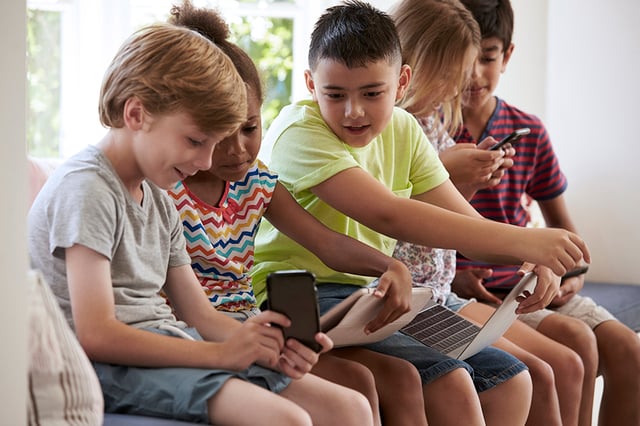Why the Digital Divide — Not the Coronavirus — Is Eroding Education
 Insights By Anna McVeigh-Murphy
Insights By Anna McVeigh-Murphy
Millions of students are unable to learn online. This problem is not new.
Once upon a time — well, in February — with Spring nearly peaking over the horizon, the school year flowed as expected. Classrooms and hallways were filled with the noise of conversing children, teachers tended to their students, and learning was in the air.
This past reality was a continuum of education as it has been for centuries — a system of learning founded on face-to-face instruction.
Though today’s classrooms look different than they would have at the earliest schools, there is still some belonging in the idea that we are a part of this centuries-old tradition of attainment, discovery, and advancement.
Bustling schools, chirping students, commanding teachers in the days of yore. ’Twas a simpler time.
Grappling With Equity in a Global Pandemic
And then comes the novel coronavirus that disrupts this system. Suddenly, millions of students across the United States (and the world) are out of school. In its place, there are sporadic attempts on a state-by-state or district-by-district basis to quickly create distance learning opportunities.
But in the face of discontinuity in the school year, millions are unable to participate, whether due to the availability of opportunity, the resources needed to take part, or the support systems to benefit from it.
This inequity leaves us to grapple with the existential question of how education should proceed in the face of a global pandemic.
In thinking about this, I often return to the idea upon which our education system was founded in the United States, and for that, we can take a quote from Thomas Jefferson.
In a bill he introduced to the Virginia state legislature, Jefferson called for the formation of a public system that provided citizens with educational opportunities “without regard to wealth, birth or other accidental condition or circumstance.” In Jefferson’s eyes, education was essential to the “preservation of freedom and happiness.”
Of course, our education system has never fully achieved this, but his idea does shape how we think about education as a tool openly accessible to all and for the greater good of society. What happens when that is so blatantly no longer possible?
A Digital Divide Emerged and Sustained
To conceptualize why a mass transition to distance learning is unfeasible and deeply inequitable, we have to understand the digital divide and its lasting implications.
One of the defining trends of the last several decades is the preeminence of technology and how it has shaped the economy, citizenship, education, and social interactions. As technology became critical to these, the digital divide came to fruition as a gap between those who have access to technology and those who do not.
With the importance of technology and the internet, access to it can mean the difference between finding and maintaining employment, completing homework, and building community. And a lack of access leads to marginalization in what is known as the access and connectivity divide.
This divide is only exacerbated in the wake of the coronavirus pandemic. Specifically, in learning environments that depend upon technology for accessing content, grades, homework, study materials, and more, access and connectivity are impediments to a students’ ability to thrive in this environment.
To understand how this digital divide affects students, we will break out the data into two sections: access and connectivity in schools and access and connectivity in homes.
Access and Connectivity in Schools
Over the last two decades, there has been a pronounced drive to outfit schools with broadband internet and adequate computing devices.
- In 1997, reports found that the ratio of students to computers was 24:1, and only 14 percent of US classrooms had internet access.
- In 2018, over fifty percent of educators reported to EdWeek that their school is 1:1; and according to a separate 2018 study by COSN, 43 percent of Technology Directors said they would be 1:1 within three years.
- And in 2019, EdWeek research confirmed that 99 percent of all K-12 districts in the United States have high-speed internet with 100kpbs for students.
The proliferation of the internet and computing devices is leading the transition to technology-enhanced learning environments; yet outside of schools, access and connectivity have largely stalled.
Access and Connectivity in Student Homes
According to census research, rates of computer ownership and internet subscriptions accelerated from 1997 to 2010 but have plateaued since. According to the most recent survey in 2015:
- 78 percent of households had a desktop or laptop.
- 75 percent had a handheld computer.
- 77 percent had a broadband subscription.
Notably, Pew Research separately confirmed that about 17 percent of American adults access the internet solely through a smartphone.
When we breakdown the census data further by demographic type, it becomes clear that rates of access and connectivity fall upon longstanding lines of inequity.
Race: For example, rates of computer ownership were 9 percent and 4.5 percent higher among White Americans when compared with their Black and Hispanic counterparts.
Further, rates of internet connectivity with 18.75 percent and 13.5 percent higher, respectively.
Income Bracket: When segregated by income bracket, the research found that between the lowest bracket (less than $25000 per year) and the middle-income bracket ($50,000–$99,999) rates of access to technology were 40 percent higher for the latter and rates of internet connectivity were 27 percent higher.
Pew Research Center additionally studied this and found that “92 percent of adults from households earning $75,000 or more per year say they have broadband internet at home, just 56 percent of adults from households earning below $30,000 say the same.”
Non-English Speakers: Households with Non-English speakers were 19.8 percent less likely to have access to computing technology and 28.7 percent less likely to have an internet subscription.
Location: Finally, households in rural areas trailed their urban counterparts in rates of access and connectivity by 9 percent and 14.2 percent.
Manifestations of Inequity
In total, 14 percent of households with school-aged children lack the internet, with most being rural, minority, and making less than $50,000 a year. In fact, low-income kids are four times as likely to lack internet access when compared with their middle and upper-income counterparts.
Despite these disparities, seventy percent of teachers assign homework that requires access and connectivity. As a result, a 2018 study found that 20 percent of children could not complete homework due to internet access.
Beyond this, a lack of access to technology and the internet puts students at an unfair competitive advantage as they advance in their schooling, with more and more homework depending upon technology literacy as they grow.
Further, students who lack access are placed at a greater inconvenience: having to wait in lines for a computer on the school campus, traveling to a library outside of school, working for longer and odder hours when access is available, and struggling to access supplemental learning and support materials online.
Moreover, even before the advent of the novel coronavirus, the digital divide created a system of inequity that disadvantages students as learning embraces or transitions to online environments. These disadvantages are haunted by larger issues of equity and hurt students who already face greater barriers to success.
For learning to be equitable — “without regard to wealth, birth or other accidental condition or circumstance” – access and connectivity are necessary both in schools and in student households. The systemic failure here is reaping nearly insurmountable challenges for students today.
School Systems in Flux
Confronting this challenge, schools, districts, and governments are having to grapple with the access and connectivity divide and tailor their approaches to distance learning accordingly. If students cannot access the internet, how can they join a virtual class, download learning material, and submit homework?
EdWeek Market Brief surveyed school leaders to assess their ability to transition to online learning, given the challenges of access and connectivity.
- No ability: 41 percent
- As long as needed: 22 percent
- The remainder of the school year: 7 percent
- One month: 3 percent
- A few weeks: 11 percent
- One week: 9 percent
- A few days: 5 percent
- One day: 3 percent
A School Year Cancelled
Given these numbers, it is usurping that states, counties, and districts alike are not moving forward with online learning as a whole or mandating that what learning happens online will not count toward credit because it is simply inaccessible to so many students.
For example, the Oregon Department of Education came forward and announced that school districts cannot replace traditional learning with online learning. Marc Siegel, the DOE’s Communications Director explained:
“Protecting student rights has to be front and center during the conversation about distance learning…You cannot open a brick-and-mortar school in Oregon unless it is accessible to every student in their school district. The same rules apply to an online school.”
Similarly, Michigan will not count online learning credits toward the yearly requirement.
Districts are also taking action.
- Schools in Philadelphia disbanded grades for remote instruction over equity concerns.
- A District in Seattle also made the difficult decision to pause online learning.
- And a district in Louisiana announced it would not pursue distance learning due to access challenges.
Learning Reconsidered
In other parts of the country, districts are creating workarounds to challenges of access and connectivity.
- An Illinois district outfitted school buses with wi-fi and is using them as roaming hotspots for students.
- Another district in Louisiana is employing bus drivers to deliver meals, drop off learning packets for students, and accept submitted homework. In addition, the district installed wi-fi on all school buildings so parents can drive up and access the internet.
- In New Hampshire, a district is using its blizzard bag system and bus drivers to get learning materials into the hands of students.
- The Los Angeles Unified School district is delivering remote learning programs over the television.
Sectors Cooperate
Outside of districts, companies and government programs are also working to ease the challenges of the digital divide.
- Spectrum and Comcast are offering new customers with K-12 or college students free internet access for 60 days.
- Educators and observers are asking the FCC to relax e-Rate rules, increase funding for hotspots, and enhance its wireless broadband spectrum.
- The FCC also waived its ban on gifts to districts from service providers so districts can receive hotspots and increased broadband connectivity.
There Was a Before, There Will Be an After
If anything, the collision of a pandemic with the digital divide brings into focus the extent of the digital disparity and exclusion in our society, accentuating the divide’s erosion of students’ abilities to learn.
But should it have come to this? Prior to this pandemic, students still could not fully participate, they waited in long lines for access to technology, and their families could not engage with their teachers.
Just a few months ago, 20 percent of students still could not complete homework and families from the lowest income bracket were 40 percent and 27 percent less likely to have access to a computing device and the internet.
This reality where education is only accessible to some students is not new. Inequity is simply magnified now.
Economists and futurists are saying this pandemic will change the landscape of how we work and live, and it can also change how we teach and learn if we can commit as a society to narrowing the digital divide.
Digital inequity existed before the pandemic, and it is accentuated during. It cannot persist after.
**This article was originally published on Age of Awareness. You can read the original here.




